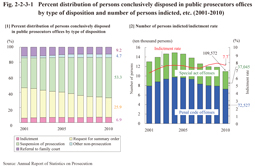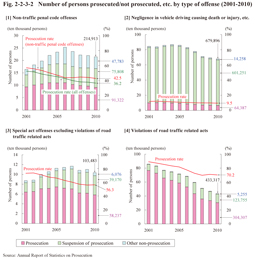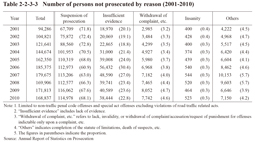Section 3 Disposition in Public Prosecutors Offices
Prosecution by public prosecutors includes indictments and requests for summary order. Non-prosecution dispositions can be grounded on [1] a lack of the conditions (a complaint in case of offenses prosecutable only upon a complaint, etc.) needed for a prosecution, [2] failure to constitute an offense (including cases of insanity), or [3] a lack of sufficient evidences to prove a criminal conduct, and can also be granted [4] as a suspension of prosecution, even with sufficient evidence to prosecute, when a public prosecutor deems it unnecessary to be prosecuted owing to the character, age, environment of the suspect, the gravity of the offense, and circumstances after the offense.
Fig. 2-2-3-1 shows the percent distribution of persons conclusively disposed in public prosecutors offices (including juvenile cases) by type of disposition, number of persons indicted, and the indictment rate over the last 10 years. Of 1,577,369 persons conclusively disposed in public prosecutors offices in 2010 (down 71,331 or 4.3% from the previous year) the number of those indicted was 109,572, that of those requested for a summary order 408,681, that of those granted suspension of prosecution 839,984, that of those not prosecuted for other reasons 73,372, and that of those referred to family courts 145,760. The number of persons indicted continued to increase every year from 1995, but then started to decrease in 2005. In 2010 it decreased by 8,975 persons (7.6%) from the previous year (See Appendix 2-2).
Fig. 2-2-3-1 Percent distribution of persons conclusively disposed in public prosecutors offices by type of disposition and number of persons indicted, etc. (2001-2010)
Fig. 2-2-3-2 shows the number of persons conclusively disposed in public prosecutors offices that were then prosecuted, granted suspension of prosecution, or not prosecuted for other reasons, and the prosecution rate by type of offense over the last 10 years (See Appendix 2-3). Negligence in vehicle driving causing death or injury, etc. and violations of traffic related acts accounted for the majority of the number of persons disposed, although the number of persons disposed and prosecuted for violations of traffic related acts significantly decreased over the last 10 years.
Fig. 2-2-3-2 Number of persons prosecuted/not prosecuted, etc. by type of offense (2001-2010)
Source: Annual Report of Statistics on Prosecution
Table 2-2-3-3 shows the number of persons not prosecuted by reason (limited to cases for non-traffic penal code offenses and special act offenses excluding violations of road traffic related acts) over the last 10 years.
In 2010 the percentage of those not prosecuted due to suspension of prosecution declined by 3.7 points from 2001 whereas the percentage of those not prosecuted due to “lack of evidence/insufficient evidence” rose by 2.7 points.
Table 2-2-3-3 Number of persons not prosecuted by reason (2001-2010)


